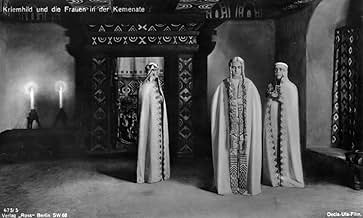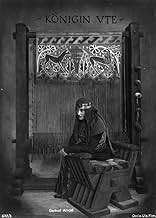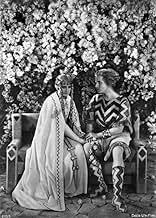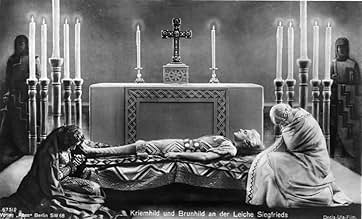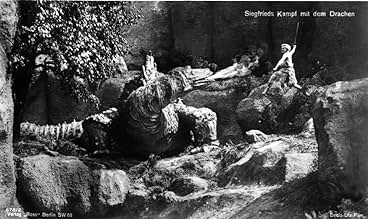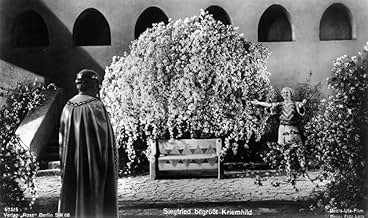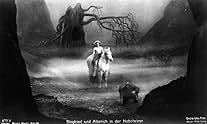IMDb RATING
8.1/10
6.7K
YOUR RATING
Siegfried, son of King Siegmund of Xanten, sets off on a treacherous journey to the Kingdom of Burgundy to ask King Gunther for the hand of his sister, the beautiful Princess Kriemhild.Siegfried, son of King Siegmund of Xanten, sets off on a treacherous journey to the Kingdom of Burgundy to ask King Gunther for the hand of his sister, the beautiful Princess Kriemhild.Siegfried, son of King Siegmund of Xanten, sets off on a treacherous journey to the Kingdom of Burgundy to ask King Gunther for the hand of his sister, the beautiful Princess Kriemhild.
- Awards
- 1 win & 2 nominations
Yuri Yurovsky
- The Priest
- (as Georg Jurowski)
- Director
- Writers
- All cast & crew
- Production, box office & more at IMDbPro
Storyline
Did you know
- TriviaThe dragon in the film is not a miniature. It is a full-scale puppet 60 feet long.
- GoofsThe tip of the spear Siegfied is killed with exits through the chest. Since Siegfried is invulnerable except at the entry point this should not be possible. The same impossible chest wound is shown later to be the one bleeding when the murderer enters the room.
- Crazy creditsKarl Vollbrecht receives a credit as "Erbauer des Drachens" -- 'dragon builder'.
- Alternate versionsA 2012 restoration project completed by the Friedrich-Wilhelm-Murnau-Stiftung has been released by Kino Lorber on both DVD and Blu-ray formats. Both "Die Nibelungen: Siegfried" (1924) and "Die Nibelungen: Kriemhild's Revenge" (1925) are included. The film's running times differ from other versions at 149 minutes and 131 minutes, respectively. This can be attributed to the fact that the restoration utilized some footage from different takes of scenes and slight adjustments were made to the 'frames-per-second' rate perhaps to present a more realistic flow of the action.
- ConnectionsEdited into Fritz Lang, le cercle du destin - Les films allemands (2004)
Featured review
UFA's Die Nibelungen films have suffered from a problem common to Metropolis, King Kong and Snow White and the Seven Dwarfs, in that they are motion picture classics that also happen to have been favourites with Adolf Hitler. While those others I mentioned tend to be overlooked as coincidences evidence of nothing more than that sometimes even fascist dictators have taste the Nibelungen pictures have fared a little worse because of the significance of the legend to German nationalism, as typified in the opera by the German anti-Semite Wagner.
However, while the Nazis may have been able to project their racial ideology onto the original story, Fritz Lang's direction of the motion picture version actually breaks with the heroic nationalist reinterpretation. Wagner's opera was calculated to be exciting and rousing. Screenwriter Thea von Harbou would eventually become a nazi stooge, and probably intended a similar effect for the film. The original poem Nibelungenlied though is not intrinsically nationalistic it is simply a folk tale in a similar vein the King Arthur legend or the Iliad, and Lang recognised this fact. Like those ancient sagas from which it is drawn, his version is lacking in any kind of emotional manipulation, yet is rich in pageantry and poetic imagery. In Die Nibelungen we in fact have a perfect example of how a director's formal technique can shape the tone of a film.
Throughout the picture, Lang takes a cool, detached approach to the material. There are few close-ups or point-of-view shots. We know that Lang was not averse to these techniques look at his previous picture, Dr Mabuse, where the title character is often staring straight into the lens, as if to hypnotise the audience. Let's also compare the dragon slaying scenes from Die Nibelungen and the Douglas Fairbanks Thief of Bagdad (directed by Raoul Walsh). The important difference here is not who had the best dragon (and to be fair they are both pretty naff), but how they are filmed. For the Fairbanks legend to work, you have to get swept up in the action, and Walsh places the camera at the hero's back as he delivers the fatal blow, bringing the audience in for the kill too. Siegfried's fight is staged almost identically yet Lang just matter-of-factly shows it happen, even giving us the dragon's death indirectly with a shot of its tail flopping to the ground.
All this is not to say that Lang did not have respect for the Nibelungen story. He had great reverence for it, but again purely in the form of an old legend an artefact of a bygone era, not something that a modern audience can or should try to relate to, but something profound and beautiful nonetheless. Lang reflects this in the overall look of the picture, forming neat, painterly tableau, encouraging exaggerated, theatrical acting and giving the overall picture a stylised sense of rhythm. Ironically he brings it close to opera in tone, although of course this version was in no other way like Wagner's.
Lang's distinctive visual style pervades Die Nibelungen. So far, Lang had made striking use of interiors, but Siegfried's story mostly takes place outdoors. There are no rolling vistas here though. Lang creates a claustrophobic landscape out of crowding forests and overbearing rock formations. In earlier Lang films we can already see how his sets and shot compositions seem to form patterns and paths to hem in the characters and even control their movements, but now the actors almost seem to become part of the scenery. Take for example a shot about two-thirds of the way through, when Brunhild is framed between two curtains the pattern on her dress matches that on the curtains. Throughout his career Lang first and foremost shoots the sets the actors are merely a part of them.
This thoroughly Langian interpretation of the Nibelungenlied may have brought a tear to the eye of Hitler and Goebbels, but the emotional connection to the material can only have existed in their heads. To the majority of viewers, this picture and its sequel do not encourage any kind of romantic or heroic feeling. They are in a way more of an illustration than a story in their own right. While this detached style does not make for gripping viewing, the films do have an aesthetic beauty to them that makes them watchable.
However, while the Nazis may have been able to project their racial ideology onto the original story, Fritz Lang's direction of the motion picture version actually breaks with the heroic nationalist reinterpretation. Wagner's opera was calculated to be exciting and rousing. Screenwriter Thea von Harbou would eventually become a nazi stooge, and probably intended a similar effect for the film. The original poem Nibelungenlied though is not intrinsically nationalistic it is simply a folk tale in a similar vein the King Arthur legend or the Iliad, and Lang recognised this fact. Like those ancient sagas from which it is drawn, his version is lacking in any kind of emotional manipulation, yet is rich in pageantry and poetic imagery. In Die Nibelungen we in fact have a perfect example of how a director's formal technique can shape the tone of a film.
Throughout the picture, Lang takes a cool, detached approach to the material. There are few close-ups or point-of-view shots. We know that Lang was not averse to these techniques look at his previous picture, Dr Mabuse, where the title character is often staring straight into the lens, as if to hypnotise the audience. Let's also compare the dragon slaying scenes from Die Nibelungen and the Douglas Fairbanks Thief of Bagdad (directed by Raoul Walsh). The important difference here is not who had the best dragon (and to be fair they are both pretty naff), but how they are filmed. For the Fairbanks legend to work, you have to get swept up in the action, and Walsh places the camera at the hero's back as he delivers the fatal blow, bringing the audience in for the kill too. Siegfried's fight is staged almost identically yet Lang just matter-of-factly shows it happen, even giving us the dragon's death indirectly with a shot of its tail flopping to the ground.
All this is not to say that Lang did not have respect for the Nibelungen story. He had great reverence for it, but again purely in the form of an old legend an artefact of a bygone era, not something that a modern audience can or should try to relate to, but something profound and beautiful nonetheless. Lang reflects this in the overall look of the picture, forming neat, painterly tableau, encouraging exaggerated, theatrical acting and giving the overall picture a stylised sense of rhythm. Ironically he brings it close to opera in tone, although of course this version was in no other way like Wagner's.
Lang's distinctive visual style pervades Die Nibelungen. So far, Lang had made striking use of interiors, but Siegfried's story mostly takes place outdoors. There are no rolling vistas here though. Lang creates a claustrophobic landscape out of crowding forests and overbearing rock formations. In earlier Lang films we can already see how his sets and shot compositions seem to form patterns and paths to hem in the characters and even control their movements, but now the actors almost seem to become part of the scenery. Take for example a shot about two-thirds of the way through, when Brunhild is framed between two curtains the pattern on her dress matches that on the curtains. Throughout his career Lang first and foremost shoots the sets the actors are merely a part of them.
This thoroughly Langian interpretation of the Nibelungenlied may have brought a tear to the eye of Hitler and Goebbels, but the emotional connection to the material can only have existed in their heads. To the majority of viewers, this picture and its sequel do not encourage any kind of romantic or heroic feeling. They are in a way more of an illustration than a story in their own right. While this detached style does not make for gripping viewing, the films do have an aesthetic beauty to them that makes them watchable.
- How long is Die Nibelungen: Siegfried?Powered by Alexa
Details
- Runtime1 hour 40 minutes
- Sound mix
- Aspect ratio
- 1.33 : 1
Contribute to this page
Suggest an edit or add missing content

Top Gap
By what name was Die Nibelungen: Siegfried (1924) officially released in India in English?
Answer
